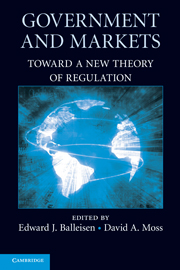Book contents
- Frontmatter
- Contents
- Acknowledgments
- Contributors
- Introduction
- SECTION I BEYOND MARKET FAILURE
- SECTION II BEYOND THE ECONOMIC THEORY OF POLITICS
- SECTION III BEYOND COMMAND AND CONTROL
- 10 What Opportunity Is Knocking? Regulating Corporate Governance in the United States
- 11 Taxation as a Regulatory Tool: Lessons from Environmental Taxes in Europe
- 12 Redesigning Regulation: A Case Study from the Consumer Credit Market
- 13 Origins and Regulatory Consequences of the Subprime Crisis
- 14 The Prospects for Effective Coregulation in the United States: A Historian's View from the Early Twenty-First Century
- 15 Deregulation Theories in a Litigious Society: American Antitrust and Tort
- 16 Markets in the Shadow of the State: An Appraisal of Deregulation and Implications for Future Research
- Conclusion
- Index
- References
16 - Markets in the Shadow of the State: An Appraisal of Deregulation and Implications for Future Research
Published online by Cambridge University Press: 20 January 2010
- Frontmatter
- Contents
- Acknowledgments
- Contributors
- Introduction
- SECTION I BEYOND MARKET FAILURE
- SECTION II BEYOND THE ECONOMIC THEORY OF POLITICS
- SECTION III BEYOND COMMAND AND CONTROL
- 10 What Opportunity Is Knocking? Regulating Corporate Governance in the United States
- 11 Taxation as a Regulatory Tool: Lessons from Environmental Taxes in Europe
- 12 Redesigning Regulation: A Case Study from the Consumer Credit Market
- 13 Origins and Regulatory Consequences of the Subprime Crisis
- 14 The Prospects for Effective Coregulation in the United States: A Historian's View from the Early Twenty-First Century
- 15 Deregulation Theories in a Litigious Society: American Antitrust and Tort
- 16 Markets in the Shadow of the State: An Appraisal of Deregulation and Implications for Future Research
- Conclusion
- Index
- References
Summary
From the late nineteenth century through the post-World War II era, the case for “economic” regulation – that is, policies that govern entry and exit, competitive practices, the size of economic units, or the prices that firms could charge – rested on a combination of two claims. First, concentrations of economic power enabled large corporations to impose monopoly prices on consumers, citizens, and potential competitors. As a result, governments had to fashion some means to hold corporations accountable and preserve competitive markets or, if this proved impossible for technical reasons, to guarantee results that would be sufficiently market-like. A second claim, most salient during the Great Depression, was that “ruinous” market competition could be the source of great instability. Left to their own devices, corporations would engage in price wars, creating destabilizing price fluctuations and bankruptcies. Regulations could inject stability by managing the conditions of competition. Regardless of the claim in question – claims that were, in practice, difficult to reconcile – policymakers asserted that regulations provided the only means of forcing higher levels of political accountability and thereby promoting the public interest.
Quite naturally, regulation became an issue of abiding interest to political scientists from the first legislative adoption of regulatory strategies to constrain the economic power of businesses. Research ranged across a host of issues including bureaucratic politics, the power of organizational life cycles, the challenges of exercising political control over regulatory bureaucracies, the relative power of competing principals, the representation of interests in the regulatory process, the dynamics of regulatory capture, the vagaries of regulatory federalism, and the quality of regulatory policies more generally.
- Type
- Chapter
- Information
- Government and MarketsToward a New Theory of Regulation, pp. 512 - 537Publisher: Cambridge University PressPrint publication year: 2009

